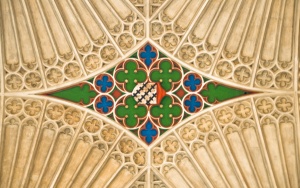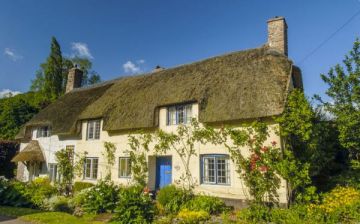
The Bishop's Dream
Sometime around 1499 Oliver King, the powerful Bishop of Bath and Wells, had a dream. King, who also served as Henry VII's Secretary, saw a vision of angels climbing a ladder to heaven, and heard a voice saying 'Let a King restore the church'.
The Bishop took this as a heavenly message that he should rebuild the Norman church of Bath Abbey as a great new cathedral. He had the old church destroyed and a grand new edifice begun in Perpendicular style. Only the chancel and aisles had been finished by the time the abbey was dissolved during the English Reformation, but the crossing tower was finished during Elizabeth I's reign.
It took another 300 years for the nave to be complete, but the core of Bath Abbey is among the best examples of late medieval architecture in England, and the Perpendicular Gothic fan vaulting is awe-inspiring.
History
The first church here was erected around 757 AD as part of a Benedictine monastery. No trace of the Saxon abbey has been found, and even the exact site is open to dispute. What we do know for certain is that Bath Abbey was the venue for one of the most important historical events in Saxon England.
It was here, on Whitsunday, in 973 AD that Edgar of Wessex was crowned King of England, the first king of a unified territory roughly analogous to modern England. The service for Edgar's coronation ceremony was devised by Dunstan, Archbishop of Canterbury, and forms the basis of the coronation ceremony still used today to crown British monarchs.

climbing a ladder
The most famous of the Saxon Abbots of Bath was Alphege, who introduced monastic reforms at Bath, and later rose to become Archbishop of Canterbury. Alphege was killed by Danish invaders after he refused to sanction his own ransom.
The Norman Church
Around 1090 John of Tours, Bishop of Wells, convinced William II to grant him the city of Bath, with the abbey and all its estates. Bishop John decided to move the bishopric to Bath and set about extending the Saxon monastery and rebuilding the abbey church in grand Norman style. When John died in 1122 only the lower walls had been built, and the rest of the work was finished under John's successor, Robert of Lewes.
When you see the abbey today it is perhaps sobering to realise that the present church is only about as large as the nave of Bishop John's original Norman church. And the original church would have been surrounded by monastic buildings and gardens, which have long since vanished. Remnants of the Norman cathedral can be seen in the form of Norman pillars in the Alphege chapel, a Norman arch in the Gethsemane chapel, and a Norman pavement on the south side of the abbey.
Later bishops moved their seat back to Wells, and the magnificent Norman cathedral fell into decay, as did Bath itself. It was left to the first Tudor bishop to restore the abbey to its former glory.

The Gothic Church
That man was Oliver King, who was appointed Bishop of Bath and Wells in 1495. We mentioned King's dream earlier. In it, he saw angels climbing a ladder to heaven. If you look at the west front of the abbey you will see this scene represented. King began work on his grand new church in 1499, but it was not finished until 1539, after Henry VIII had already begun his Dissolution of the Monasteries.
Henry's commissioners offered the church to the city of Bath but the city refused to pay, and the church was stripped of its glass and lead and left to decay. It was sold and resold, but then in 1572 Edmund Colthurst presented it to the mayor and city to serve as a parish church.
Extensive repairs were needed, and in one of those odd twists of fate, it was only when Henry VIII's daughter, Elizabeth I, threw her support behind a nationwide campaign to raise funds that the necessary repairs could be made. The cause was aided by one of Elizabeth's most prominent aides, Lord Burghley.

Bath Pump Rooms
Burghley came to Bath to take the waters in the hope they would cure his ill health. The waters had little effect, but Burghley became interested in the fate of Bath Abbey, and when he died, his executor, Thomas Bellot, lavished Burghley's funds on the abbey.
Repairs were completed by 1616 and the abbey was opened to public worship. It remained essentially unchanged - with the exception of repairs to the clock tower - until a major remodelling by Sir George Gilbert Scott in the Victorian period. The major Victorian contribution to the church we see today is the great east window, designed with stained glass by the famous firm of Clayton and Bell.
When you view the abbey today the first thing you notice is the exquisite Perpendicular Gothic fan vaulting. By the time Bishop King undertook his work, vaulting had long since ceased to be solely functional, and Bath Abbey represents one of the most ornate, flowery, and, you might say, over-the-top example of Gothic vaulting in the country (see Henry VII's chapel at Westminster Abbey for another extreme example of this style).
About Bath Abbey
Address: Bath,
Somerset,
England, BA1 1LT
Attraction Type: Historic Church
Website: Bath Abbey
Email: office@bathabbey.org
Location
map
OS: ST752 648
Photo Credit: David Ross and Britain Express
HERITAGE
 We've 'tagged' this attraction information to help you find related historic attractions and learn more about major time periods mentioned.
We've 'tagged' this attraction information to help you find related historic attractions and learn more about major time periods mentioned.
Historic Time Periods:
Find other attractions tagged with:
Clayton and Bell (Person) - Elizabeth I (Person) - Gilbert Scott (Person) - Henry VII (Person) - Henry VIII (Person) - Medieval (Time Period) - Norman (Architecture) - Perpendicular (Architecture) - Reformation (Historical Reference) - Saxon (Time Period) - Tudor (Time Period) - Victorian (Time Period) - William II (Person) - William II (Person) -
NEARBY HISTORIC ATTRACTIONS
Heritage Rated from 1- 5 (low to exceptional) on historic interest
Sally Lunns House - 0 miles (Museum) ![]()
The Roman Baths - 0.1 miles (Roman Site) ![]()
Victoria Art Gallery - 0.1 miles (Museum) ![]()
Bath Postal Museum - 0.2 miles (Museum) ![]()
William Herschel Museum - 0.3 miles (Museum) ![]()
Jane Austen Centre - 0.3 miles (Museum) ![]()
Bath Assembly Rooms - 0.4 miles (Historic Building) ![]()
Fashion Museum, Bath - 0.4 miles (Museum) ![]()












